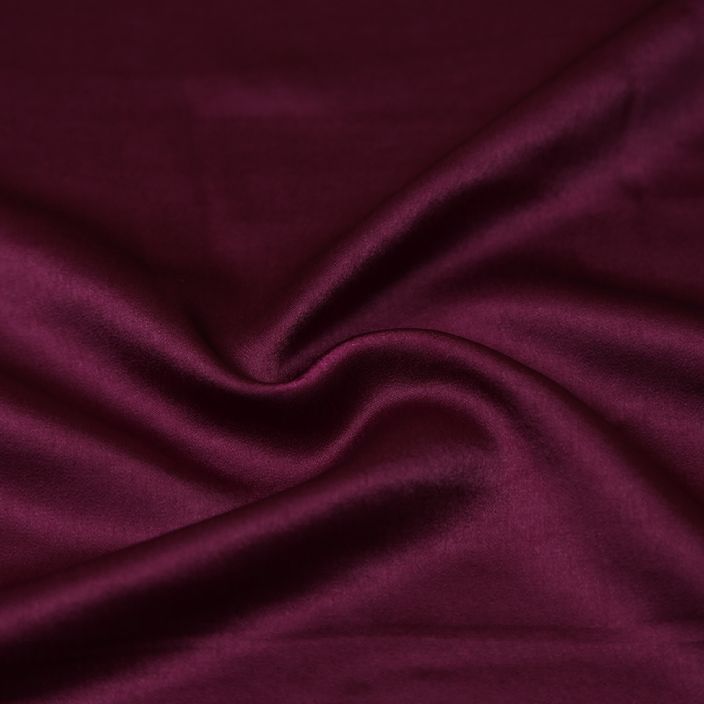For best prices and early deliveries, WhatsApp us at. 918488070070

Satin
Satin fabric, renowned for its glossy sheen and smooth texture, is a pinnacle of luxury in fashion and decor. Unlike a fibre-based textile, satin refers to a weave characterised by long floats, where warp or weft yarns skip multiple threads, creating a lustrous surface. The silky satin cloth material, historically crafted from silk, now includes blends like Japanese satin fabric, polyester, or cotton, offering versatility across various kinds of satin fabric for modern wardrobes. The allure of satin lies in its reflective surface, which captures light, lending elegance to silhouettes crafted using satin. Its fluid drape and soft touch make satin ideal for warm climates, providing comfort without sacrificing sophistication. Whether it's plain satin fabric used for minimalist designs or patterned satin dresses for bold statements, this textile adapts to diverse aesthetics. Satin’s eco-conscious potential depends on its fibre composition. Silk-based satin fabric cloth, such as Japan satin fabric, is biodegradable but resource-intensive, while synthetic blends offer affordability and durability. Satin material’s ability to absorb dyes creates vibrant hues, from rich jewel tones to soft pastels, making it a favourite for couture and prêt collections. Beyond apparel, satin extends to home decor, from luxurious bedding to elegant curtains, with satin lining adding refinement to upholstery. Its versatility spans casual satin dresses, formal gowns, and accessories like scarves or clutches. As fashion embraces versatility, kinds of satin fabric, including silky satin and Japan satin fabric, remain staples due to their ability to balance heritage craftsmanship with contemporary flair, making satin a symbol of enduring luxury.
The Making of Satin
The creation of satin fabric is a process that transforms fibres into a luxurious satin textile, renowned for its glossy finish and smooth texture. Whether crafted from silk, polyester, or blends like Japan satin fabric, the production of satin fabric involves precise weaving and finishing techniques, resulting in a versatile satin fabric used in everything from satin dresses to satin home decor pieces.
The process begins with selecting fibres. Silk, historically used for silky satin, is harvested from silkworm cocoons, requiring careful extraction to preserve long filaments. Synthetic fibres, such as polyester for satin fabric or cotton blends, offer durability and cost-effectiveness. These fibres are spun into fine yarns, with silk requiring delicate handling to maintain its sheen, while synthetics ensure consistency for various kinds of satin fabric, like bridal satin fabric or plain satin fabric.
Weaving is the heart of satin production, defined by the satin weave structure, where warp yarns float over multiple weft yarns, creating a smooth, lustrous surface. This technique, typically a four-over-one or five-over-one pattern, minimises yarn interlacing, enhancing the satin cloth material’s reflective quality.
Looms are calibrated for precision, especially for bridal satin material, to ensure a flawless finish. Japanese satin fabric often uses high-quality polyester for durability, while silky satin relies on silk for its luxurious hand-feel.
Post-weaving, the satin fabric cloth undergoes finishing processes. Scouring removes impurities, particularly for silk-based satin dress fabric, while dyeing enhances its vibrant palette, from bold tones for patterned satin dresses to soft shades for bridal satin fabric. Calendering, a process of pressing the fabric between rollers, polishes the surface, amplifying the sheen of plain satin fabric. For satin lining fabric, additional treatments ensure smoothness and durability, making it ideal for structured garments.
While silk-based satin fabric material is biodegradable, its production is labour-intensive, increasing costs. Synthetic blends reduce environmental impact through scalability but may lack biodegradability. Quality control ensures the satin cloth fabric is free of flaws, with its glossy finish and fluid drape making it a premium choice for satin fabric dresses and decor.
Utility
Satin’s versatility shines across diverse silhouettes in luxury fashion, catering to women, men, and children. The glossy sheen of silky satin and the fluid drape of satin cloth material suit warm climates, while the strength of satin fabric supports structured designs, making it ideal for various occasions.
In women's wear, satin fabric is used to craft flowing gowns and sarees, whereas bridal satin fabric is enhanced using intricate embroideries, creating opulent wedding looks. Anarkalis and lehengas crafted using satin exude festive elegance, while satin fabric dresses, including patterned satin dresses, provide modern sophistication for eveningwear. Fusion co-ord sets and slip dresses in plain satin fabric blend casual chic with luxury, with satin lining fabric adding comfort to structured pieces.
Menswear leverages satin textile’s refined aesthetic in tailored suits and bandhgalas. Japan satin fabric ensures durability in sherwanis and Indo-Western jackets, making them ideal for formal occasions, while silky satin adds a luxurious touch to evening shirts.
Satin lining fabric enhances structured blazers, balancing elegance and comfort, with plain satin fabric offering a sleek, minimalist look for contemporary silhouettes.
In kidswear, satin fabric material’s softness and durability help create charming occasion wear, such as mini lehengas or tailored kurtas. Patterned satin and satin material dresses make for vibrant, festive looks, while satin cloth material ensures comfort during celebrations, making it a practical yet stylish choice.
From breezy pret to intricate couture, the different kinds of satin fabric, including Japan satin fabric and bridal satin material, offer unmatched versatility. Whether through satin dresses or decorative accents, satin delivers unmatched luxury, blending heritage and modernity across generations.
Image Credits
HP Singh